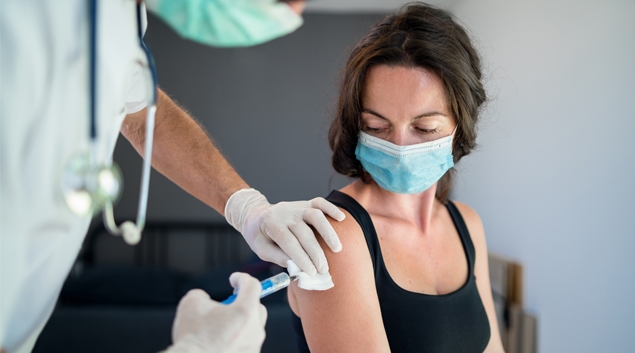PROVO, Utah – Across Utah, the number of adults fully immunized against the coronavirus is approaching 1 in 3, putting the state just above national averages. More than 70% of seniors statewide have been vaccinated.
But some rural counties are lagging far behind, according to state data obtained by The Salt Lake Tribune, with fewer than half of their seniors fully inoculated — even though they have been eligible for weeks, and Utahns age 70 and up have been eligible since mid-January.
Health officials chalk up the disparities to both challenges in accessing vaccine and less interest.
But more Utah pharmacies will be providing shots through partnerships with federal agencies, said Tom Hudachko, spokesman for the Utah Department of Health, to meet President Joe Biden’s promise that at least one vaccine provider is within 5 miles of 90% of Americans by Monday. Because 85% of Utah’s population lives along the Wasatch Front, he noted, state health officials believe Utah already meets that standard.
And new federal data shows that while Utahns are not the Americans least likely to feel hesitant about coronavirus vaccines, residents here are notably more accepting of vaccination than those in most of the rest of the Mountain West.
In Daggett County, just one shot at a shot
Vaccination rates, as a percent of total population, range broadly across Utah’s rural areas, from more than 46% in eastern Summit County to just over 20% in the Eagle Mountain area, the rural parts of southern Utah County, and Daggett and Duchesne counties. (State data varies from federal numbers, due to a state reporting error that has not been fixed by the Centers for Disease Control and Prevention.)
In Daggett County, as of early April, just 21.6% of residents age 65 and older had been vaccinated, according to the state health department.
That’s due in part to the county’s tiny population — barely 600 people — which means small changes like a single vaccine clinic can have a big effect.
It’s also likely that some residents sought their vaccines in Green River, Wyo., which is just a 45-minute drive from the county seat of Manila, said Liberty Best, spokeswoman for the TriCounty Health Department of eastern Utah.
The trip to Vernal, the next nearest city and the site of most vaccinations in the area, is nearly twice as long. Vaccinations in other states are not necessarily reported to Utah health officials.
But between Green River and Vernal, vaccination opportunities are few and far between. Public health officials have offered just two vaccine clinics to Manila’s 300 people: first doses of Moderna vaccines were given to residents over age 50 in March, and those same residents recently got their second doses, when health officials also provided the one-shot Johnson & Johnson vaccine to anyone not previously vaccinated.
“It’s going to be our last clinic up there,” Best said. “Otherwise, we’ll be going every four weeks, and we just don’t have the staff for that.”
That means most of Manila’s residents had only one chance to get vaccinated anywhere near their homes, compared to the daily vaccine clinics running along the Wasatch Front.
The good news: at last week’s clinic, health officials administered more than 125 shots, Best said — which amounts to about 20% of the county becoming fully vaccinated in a single day.
“I was pretty tickled and impressed with how they handled it here,” said Curtis White, 64, who lives in Manila and was one of the people vaccinated at the clinic.
Demand varies among counties — and vaccines
Residents in rural Utah consistently express slightly more “vaccine hesitancy” than residents along the Wasatch Front and in larger cities, according to survey data from the CDC.
(Christopher Cherrington | The Salt Lake Tribune)
In Utah’s counties, 13% to 17% of residents were hesitant to get vaccinated, a report on the survey said, with 5% to 7% “strongly hesitant.”
The lowest rates of hesitancy were found in Davis and Washington counties, with Salt Lake, Summit, Cache, Morgan, Utah and Rich counties close behind. The highest rates of vaccine hesitancy were in Duchesne, Uintah, Carbon, Emery, Wasatch, San Juan, Daggett and Grand counties.
But Utah’s hesitancy rates were not exceptional compared to the rest of the nation. As few as 6% of residents were hesitant to get vaccinated in multiple Massachusetts counties, compared to more than 30% of residents in nearly all of Wyoming’s counties.
In some Utah counties, the age of the local population may affect vaccine uptake; many residents of college towns, for instance, only recently became eligible for the vaccine. But even among communities with similar age makeup, vaccination rates vary widely.
Within southeast Utah, for instance, more than 45% of Grand County residents have had at least one dose — a figure that drops to just over 30% in neighboring Emery County.
“Grand County is going bonkers for vaccines. Every appointment we put out for Grand County is used up,” said Bradon Bradford, director of the Southeast Utah Health Department.
By contrast, 160 vaccine slots made available in March in Emery County were only half-full two weeks later. In southeast Utah, Bradford said, “that’s the county I’d probably expect to get the least vaccinated.”
Skepticism of the coronavirus and of COVID-19 vaccines has been relatively widespread there, Bradford said. Emery County also has the region’s highest rate of vaccine exemptions for school-age children, he said.
Although Emery County residents have generally eschewed the Pfizer and Moderna vaccines, the Johnson & Johnson vaccine is popular, Bradford said.
“We do have a pharmacy partner doing Johnson & Johnson, but we only sent 100 [doses],” he said. In Emery County, those appointments were snapped up immediately.
But federal regulators have “paused” the administration of the Johnson & Johnson vaccine while researchers investigate treatment protocols for rare blood clots, which six women developed after being among the 6.8 million Americans receiving the vaccine.
So far, more vaccinations don’t always mean fewer new cases
So far, Utah’s data does not show a strong correlation between vaccination rates and a slowed pace of new coronavirus cases — though the state provides local data only for the percentage of residents who have received at least one dose, a figure that includes many people who are not yet fully vaccinated.
It also doesn’t account for any degree of potential immunity conferred by previous outbreaks; in the northern neighborhoods of Orem, for example, more than 20% of the population already has been infected with the virus.
Some towns and neighborhoods with the state’s highest vaccination rates also have some of the state’s highest rates of new cases in the past two weeks.
For instance, Grand County, where every vaccine appointment is filled almost as soon as it opens, has the highest rate of new cases per capita of all 99 of Utah’s “small areas,” used by public officials to track health data. Park City, which has the state’s highest vaccination rate at more than 60%, also has the state’s ninth-highest rate of new cases per capita.
Meanwhile, Spanish Fork, which has the 16th-lowest vaccination rate of 26%, has the state’s third-lowest rate of new cases.
However, there also are a number of communities where recent case rates and vaccination rates do correlate. Cedar City, for example, has the state’s third-highest rate of new cases, and the 8th-lowest vaccination rate, with only 24% of residents receiving at least one dose.
And Saratoga Springs, where only about 25% of people have been vaccinated, has the state’s fourth-highest rate of new cases — even though more than 14% of residents there already have had the coronavirus.
At this point, UDOH epidemiologists aren’t concerned about the lack of correlation between vaccination rates and new cases, Hudachko said, especially at the local level. In addition to the risk of infection of people who are only partly vaccinated, he noted that new cases are “most likely” among people who still aren’t vaccinated.
“Notably, cases among older individuals and those in [long-term care facilities] have decreased,” he said. “We have not seen as dramatic effects in the younger population, which hasn’t been eligible for vaccination as long.”
And Park City and Grand County specifically may be particularly vulnerable to new cases, he said. In those communities, Hudachko said, “there is a strong tourism industry with many travelers and younger people working in bars and restaurants, which are potentially higher risk occupations.”






